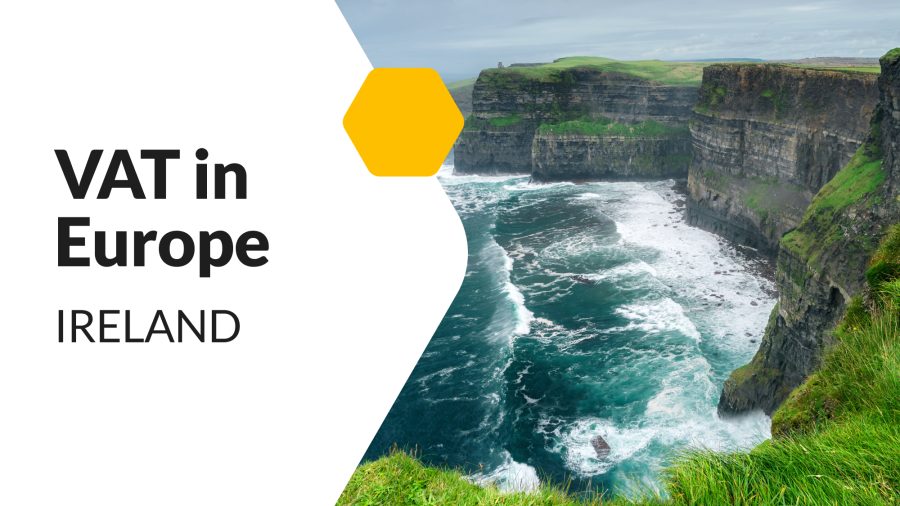Are you sending goods to customers in Ireland? Check if you should register for the Irish VAT and find out the applicable VAT rates in Ireland.
VAT in Ireland - table of contents:
In preparation for joining the European Union, which occurred in 1973, Ireland decided to introduce the Value Added Tax (VAT) a year earlier. System VAT in Ireland, like in other EU countries, is primarily based on directives (laws) regarding VAT proposed by the European Union.
All foreign companies providing services subject to Irish taxation may be required to account for VAT. The requirement for registration of a foreign company is associated with assigning an individual VAT number. Subsequently, it will be possible to register and report various types of transactions. This principle may also apply to imports. The frequency of registrations for non-resident business entities is gradually diminishing.
The tax office in Ireland (locally referred to as the Revenue Commission) is responsible for managing the VAT system. It encompasses issuing regular communications related to the daily compliance with VAT regulations.
Should you register for Irish VAT?
Similar to other EU countries, in Ireland, companies may need to register for local VAT. Registration for Irish VAT is required in certain situations, such as:
- importing goods into the EU through Ireland,
- buying and selling goods within the country,
- operating a consignment warehouse storing goods for further sale to local businesses
- organizing live events, exhibitions, or conferences (with paid admission at the entrance)
- selling goods to Irish customers via the Internet.
Important! Entrepreneurs providing services and selling goods online to consumers within the EU, whose turnover from such sales exceeds 10,000 euros (for all countries), instead of registering for Irish VAT, may opt to register for VAT OSS.
What are the VAT registration thresholds in Ireland?
Similar to most European Union member countries, Ireland does not have a VAT registration threshold for non-resident tax entities, except for the sale of goods and the provision of services to Irish customers via the Internet, as mentioned above.
Is an Irish fiscal representative or agent required?
In Irish law, there is no requirement for a fiscal representative. Non-tax resident companies are not obligated to appoint one.
How to register for Irish VAT?
Foreign companies required to register for Irish VAT should submit their VAT registration application to the following address:
National TAIN Unit
Office of the Revenue Commissioners
PO Box 1
Wexford.

How to settle VAT in Ireland?
The tax must be paid by the 19th or 23rd day of the month following the end of each tax period. Also, within this timeframe, the VAT-3 declaration must be submitted to the Irish Revenue Online Service – ROS.
VAT tax periods
The tax period is a two-month period starting on the first day of January, March, May, July, September, and November. However, the General Inspector may allow for the following tax periods:
- annual, if equal installments are paid through a payment order,
- quarterly, if the annual VAT obligation ranges from 3001 EUR to 14,400 EUR,
- semi-annual returns, if the annual obligation is 3000 EUR or less.
VAT rates in Ireland
| 23% | standard |
|
| 13,5% | reduced |
|
| 9% | reduced |
|
| 4,8% | reduced |
|
| 0% | zero |
|
Five different VAT rates are also applicable in France. Learn more about VAT in France in our comprehensive guide.
If you like our content, join our busy bees community on Facebook, Twitter, LinkedIn, Instagram, YouTube, Pinterest, TikTok.
Author: Lucy Adams
She has extensive knowledge in the field of accounting and constantly gains experience working for both small businesses and larger corporations. Her mission is to explain complex financial and accounting issues and teach business owners and those interested in the subject how to manage their finances effectively. She enjoys giving practical advice, discussing current accounting issues, and analyzing legislative changes that may affect business operations. She enjoys a straightforward approach to finance that helps entrepreneurs focus on growing their businesses. She translates complex issues into easy-to-understand language so that anyone can confidently make decisions that impact the success of their business.
VAT in EU:
- VAT in Estonia - a complete guide
- VAT in Denmark - a complete guide
- VAT in Germany - a complete guide
- VAT in the Netherlands - a complete guide
- VAT in the Czech Republic - a complete guide
- VAT in Italy – a complete guide. Rates and registration thresholds
- VAT in Ireland – a complete guide. Rates and registration thresholds
- VAT in Cyprus – a complete guide
- VAT in Spain – a complete guide. Rates and registration thresholds
- VAT in France - a complete guide
- VAT in Lithuania - a complete guide
- VAT in Latvia - a complete guide
- VAT in Slovakia - a complete guide
- VAT in Portugal - a complete guide
- VAT in Romania - a complete guide
- VAT in Belgium - a complete guide
- VAT in Sweden - a complete guide
- VAT in Hungary - a complete guide
- VAT in Greece - a complete guide
- VAT in Finland- a complete guide
- VAT in Austria - a complete guide
- VAT in Malta - a complete guide. Rates and registration thresholds
- VAT in Croatia - a complete guide
- VAT in Slovenia - a complete guide
- VAT in Luxembourg - a complete guide

Set and accomplish your
team goals with Firmbee
21
years
of experience
1.2 M
users trusted
our solutions
+200
team
of experts
+50 M
processed
documents yearly

















